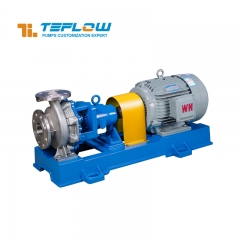In the chemical production process, chemical pumps are key equipment for transporting various corrosive, flammable, explosive, or high-temperature and high-pressure media. Their stable operation is directly related to production efficiency and safety. However, the occurrence of cavitation often causes a series of serious damages to chemical pumps, becoming a potential hidden danger that restricts production.
Cavitation refers to when the local pressure in a chemical pump drops to a level equal to or lower than the saturated vapor pressure of the conveying medium at that temperature, the medium will quickly vaporize and produce a large number of bubbles. When these bubbles flow with the liquid to the high-pressure area, they will quickly condense and burst, producing a strong water hammer effect under the impact of the surrounding liquid. This repeated impact and destruction will first cause serious damage to the flow-through components of the pump. The surfaces of components such as the impeller, pump casing, and guide vanes will gradually develop pitting and honeycomb-like holes, and in severe cases, even cracks and perforations will appear. For chemical pumps that transport corrosive media, the impact of cavitation will destroy the passivation film on the metal surface, accelerate the corrosion of the medium on the metal, form a synergistic effect of cavitation and corrosion, and greatly shorten the service life of the components.
In addition to component damage, cavitation can also cause a significant decrease in chemical pump performance. As the degree of cavitation intensifies, the large amount of bubbles generated in the pump will occupy the flow channel space, reducing the actual flow area, resulting in a significant decrease in flow rate and head. At the same time, the efficiency of the pump will also drop significantly, and energy consumption will increase significantly. During operation, the pump will experience abnormal vibration and noise. This vibration will not only affect the stability of the pump itself, but may also be transmitted to the entire system through the pipeline, causing resonance in other equipment and affecting the overall operating accuracy of the production system.
The harm caused by cavitation is also reflected in production safety. When the performance of chemical pumps becomes unstable due to cavitation, it may cause fluctuations in the flow and pressure of the conveying medium, affecting the stability of the chemical reaction and even causing product quality failure. For pumps conveying flammable and explosive media, the sparks generated by cavitation may become a safety hazard, increasing the risk of fire and explosion. In addition, sudden damage to components caused by cavitation may cause medium leakage. If the medium is toxic or corrosive, it will threaten the health of operators and pollute the environment.
In view of the serious harm of cavitation, it is particularly important to take targeted preventive measures:
1.Design Optimization
During the design phase, it is necessary to optimize the parameters of the pipeline and pump body, reasonably calculate the installation height of the pump, ensure that the pressure at the pump inlet is higher than the saturated vapor pressure of the medium at the operating temperature, and reduce the local pressure drop. At the same time, select impellers, pump casings and other flow components with streamlined flow channels to reduce the resistance loss of the fluid in the pump.
2.Standardized operation control
In terms of operation control, the medium status and operating parameters must be strictly monitored. Avoid operating the pump at too low a liquid level to prevent negative pressure in the suction line; control the medium temperature through the cooling system to reduce the saturated vapor pressure of the medium; when transporting easily vaporized media, the inlet pressure can be appropriately increased to enhance the medium's anti-cavitation ability. In addition, it is necessary to avoid operating the pump under conditions exceeding the design flow range to prevent a sudden drop in inlet pressure due to excessive flow.
3.Strengthen maintenance management
Equipment maintenance needs to strengthen regular inspections and component upgrades. Clean the filter of the suction line regularly to prevent impurities from clogging the flow channel and causing local pressure drop; for components susceptible to cavitation damage, such as impellers, use high-hardness, high-toughness wear-resistant materials (such as duplex stainless steel, ceramic coating, etc.) to manufacture or repair them to improve the components' anti-cavitation performance. At the same time, a vibration and noise monitoring mechanism was established to detect early signs of cavitation through online monitoring equipment and take intervention measures in advance.





 +86 18130251359
+86 18130251359 teflowpumps@tlpumps.com
teflowpumps@tlpumps.com











 +86+0563-5093318
+86+0563-5093318
